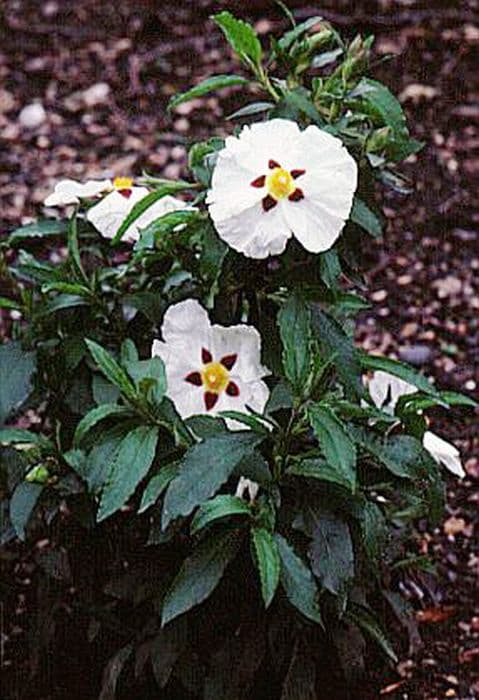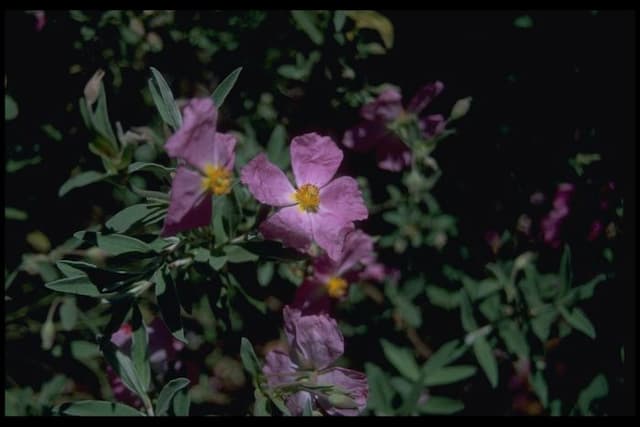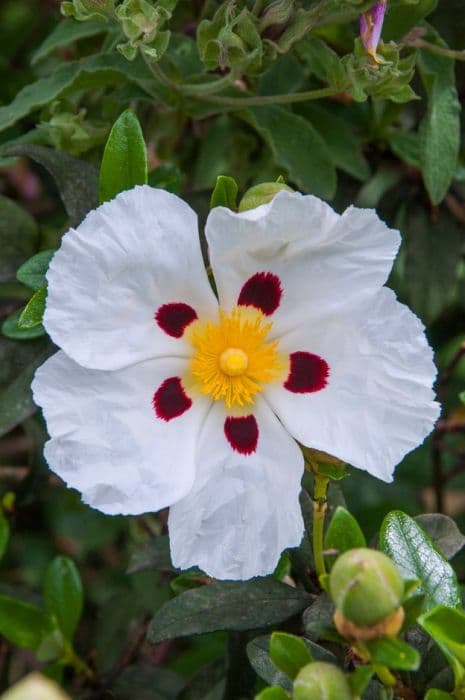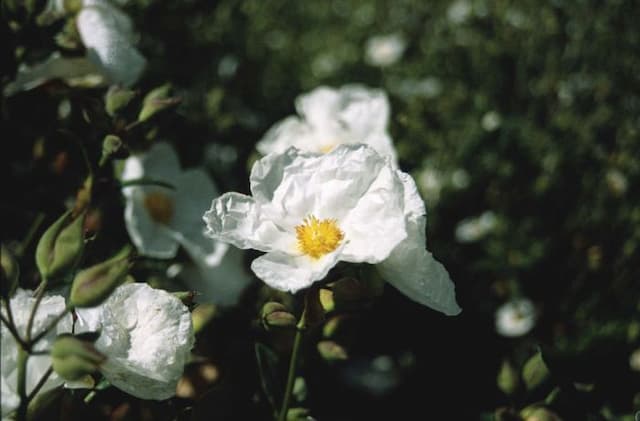Cistus 'Jessamy Beauty'

ABOUT
The Cistus 'Jessamy Beauty' is a delightful shrub that is widely appreciated for its ornamental qualities. This plant is characterized by its showy flowers and lush, evergreen foliage. The flowers are a standout feature, with a soft, creamy-pink hue that draws the eye. They possess a tissue-paper-like texture, which gives them a delicate and ephemeral quality. The blossoms typically have a yellow center, which contrasts nicely with the pink petals, making them appear even more vibrant. The foliage of the 'Jessamy Beauty' is also quite attractive. The leaves are a deep green color with a slightly glossy finish, which provides a beautiful backdrop for the lighter colored flowers. The plant has a bushy and dense growth habit, which allows it to present as a full and robust shrub. Its leaves are often described as being somewhat sticky to the touch, which is a characteristic feature for the plant. Overall, the Cistus 'Jessamy Beauty' is known for its charming appearance and its resilience in the garden. It brings a touch of Mediterranean flair to the landscape with its beautiful blooms and aromatic foliage, making it a favorite among garden enthusiasts.
About this plant
 Names
NamesFamily
Cistaceae
Synonyms
Jessamy Beauty Rockrose, Cistus 'Jessamy Beauty'
Common names
Cistus 'Jessamy Beauty'.
 Toxicity
ToxicityTo humans
Rockrose is generally considered non-toxic to humans. There are no well-documented cases of poisoning from Rockrose, and it is not known to have toxic properties that would pose a threat if ingested by humans. However, as with any plant, individual allergies or sensitivities are possible, and it is always advisable to avoid eating plants that are not commonly recognized as food.
To pets
Rockrose is not known to be toxic to pets. There is no significant evidence to suggest that Rockrose poses a risk of poisoning to animals if they ingest parts of the plant. However, individual animals may have different sensitivities or allergic reactions, and it is always best to monitor pets and prevent them from eating ornamental plants as a precaution.
 Characteristics
CharacteristicsLife cycle
Perennials
Foliage type
Evergreen
Color of leaves
Green
Flower color
Pink
Height
3 feet (0.91 meters)
Spread
5 feet (1.52 meters)
Plant type
Shrub
Hardiness zones
8
Native area
Mediterranean
Benefits
 General Benefits
General Benefits- Ornamental Appeal: Cistus 'Jessamy Beauty' (Rock Rose) has attractive flowers that enhance garden aesthetics.
- Drought Tolerance: This plant is well-suited for dry climates and low-water gardens.
- Low Maintenance: Rock Rose typically requires minimal care once established.
- Rapid Growth: Cistus 'Jessamy Beauty' tends to grow quickly, filling in garden spaces efficiently.
- Attracts Pollinators: The flowers attract bees, butterflies, and other beneficial insects to the garden.
- Deer Resistance: Rock Roses are generally resistant to deer, making them suitable for areas with wildlife.
- Suitable for Coastal Areas: Tolerates salty winds and soil, making it ideal for coastal locations.
- Erosion Control: Its root system helps stabilize slopes and prevent soil erosion.
- Adaptable: It can thrive in a variety of soil types, provided they are well-draining.
 Medical Properties
Medical PropertiesThis plant is not used for medical purposes.
 Air-purifying Qualities
Air-purifying QualitiesThis plant is not specifically known for air purifying qualities.
 Other Uses
Other Uses- Cistus 'Jessamy Beauty', commonly known as rockrose, can be used as a natural dye for fabrics, with different parts of the plant yielding various shades of color.
- The rockrose can be incorporated into perfumery for its resinous scent, harvested from the sticky substance on its leaves and stems.
- The shrub, when planted in groups, can act as a sound barrier, reducing noise pollution in gardens near busy roads.
- In landscaping, rockrose can be used for erosion control on slopes due to its root system that helps to stabilize soil.
- With its dense and bushy habit, rockrose can serve as a sanctuary for beneficial insects, offering a safe haven for pollinators and predatory insects.
- Rockrose leaves can be soaked in water to create a natural insect repellent for garden planters.
- The dried leaves and petals of the rockrose can be used to make potpourri, adding a Mediterranean touch to home fragrance.
- Rockrose can be used in floral arrangements as a filler plant due to its attractive foliage and flowers, enhancing the bouquet's structure and longevity.
- The plant can act as a natural mulch as its fallen leaves decompose, enriching the soil with organic matter.
- Rockrose provides a dry, shaded microhabitat for reptiles and small mammals, offering them a cool retreat during hot summers.
Interesting Facts
 Feng Shui
Feng ShuiThe Cistus 'Jessamy Beauty', commonly known as Rockrose, is not specifically used in Feng Shui practice.
 Zodiac Sign Compitability
Zodiac Sign CompitabilityThe Rockrose is not used in astrology practice.
 Plant Symbolism
Plant Symbolism- Resilience: Cistus, commonly known as Rock Rose, is known for its ability to thrive in harsh, dry conditions, symbolizing the ability to persevere and endure challenges.
- Purity: The white to light pink flowers of the Rock Rose may represent purity and innocence.
- Beauty: With its attractive blooms, Rock Rose embodies beauty and appreciation for the aesthetics.
- Healing: Since some Cistus species are used in herbal medicine for their healing properties, the plant can symbolize health and recovery.
- Temporal Nature: The flowers of Rock Rose often only last for a single day, symbolizing the fleeting nature of life and the importance of living in the present moment.
 Water
WaterRockrose 'Jessamy Beauty' should be watered deeply once a week during dry periods, allowing the soil to dry out between waterings. In particularly hot and dry climates, increase the frequency to twice a week. Ensure each watering saturates the soil to a depth of 1 to 2 inches. Over winter, reduce watering significantly, as the plant is dormant and too much water can lead to root rot. It's important not to waterlog the soil, as rockrose prefers well-drained conditions. An established rockrose typically requires around 1 gallon of water per week, but this may vary based on local climate and soil conditions.
 Light
LightRockrose 'Jessamy Beauty' thrives best in full sunlight. Place the plant in a location where it will receive at least 6 to 8 hours of direct sunlight daily, which is crucial for optimal growth and bloom. Although it can tolerate partial shade, flowering may be reduced in less sunny spots. Avoid deep shade areas, as this can lead to leggy growth and sparse flowering.
 Temperature
TemperatureRockrose 'Jessamy Beauty' can withstand a wide range of temperatures and is hardy in USDA zones 8 to 11. The plant can survive temperatures as low as 15°F, although it prefers a warmer climate for vigorous growth. The ideal temperature range for rockrose is between 60°F and 80°F. They are adapted to coastal and hot, dry inland climates and can tolerate high summer temperatures well above 80°F.
 Pruning
PruningRockrose 'Jessamy Beauty' benefits from occasional pruning to maintain shape and promote vigorous growth. Prune in late winter or early spring before new growth begins. Trim back the previous year's growth by about one-third to stimulate new flowering shoots. Regular pruning also prevents the plant from becoming woody and sparse. The best time for pruning rockrose is immediately after it has finished blooming.
 Cleaning
CleaningNot needed
 Soil
SoilRock Rose 'Jessamy Beauty' thrives in well-draining soil with a mix of loam, peat, and sand. The ideal pH range for this plant is slightly acidic to neutral, between 5.5 and 7.5. Incorporate organic matter to enrich the soil blend and ensure adequate drainage.
 Repotting
RepottingRock Rose 'Jessamy Beauty' does not need frequent repotting and can be done every 2-3 years. When repotted, choose a slightly larger pot with good drainage to accommodate growth.
 Humidity & Misting
Humidity & MistingRock Rose 'Jessamy Beauty' is tolerant of a wide range of humidity levels but prefers moderate to low humidity typical of its Mediterranean origin. It does not require high humidity to thrive.
 Suitable locations
Suitable locationsIndoor
Place in bright indirect light and well-draining soil.
Outdoor
Plant in sun, shelter from wind, well-draining soil.
Hardiness zone
8-11 USDA
 Life cycle
Life cycleCistus 'Jessamy Beauty', commonly known as Rock Rose, begins its life cycle with seed germination, provided the conditions are right—usually in a well-draining soil and full sun exposure. As a herbaceous perennial, once the seedling emerges, it progresses rapidly to the vegetative stage, where it develops a robust root system and foliage. During spring and early summer, the Rock Rose enters the flowering stage, showcasing its showy, crinkled flowers that typically last for one day. After pollination, seeds are produced and dispersed, though propagation is more commonly achieved through semi-hardwood cuttings. The plant has a period of dormancy during the colder months, especially in areas with cooler climates. Throughout its life cycle, which can extend to several years in the right conditions, Rock Rose may need occasional pruning to maintain shape and encourage new growth.
 Propogation
PropogationPropogation time
Spring-Early Summer
The Cistus 'Jessamy Beauty', commonly known as Rockrose, is typically propagated through semi-hardwood cuttings. The ideal time to take these cuttings is in late summer after the bloom period has ended, ensuring that the plant is not actively growing. Cuttings should be about 4-6 inches (10-15 cm) long, taken from healthy, disease-free branches. Remove the lower leaves and dip the cut end into rooting hormone powder to encourage root growth. Then, insert the cuttings into a well-draining soil mix, ensuring that at least two nodes are buried where leaves were removed. The soil should be kept moist but not waterlogged, and the cuttings should be placed in an area with bright, indirect light. Roots typically develop within a few weeks to a couple of months, after which the new Rockrose plants can be gradually acclimated to their permanent positions in the garden.









